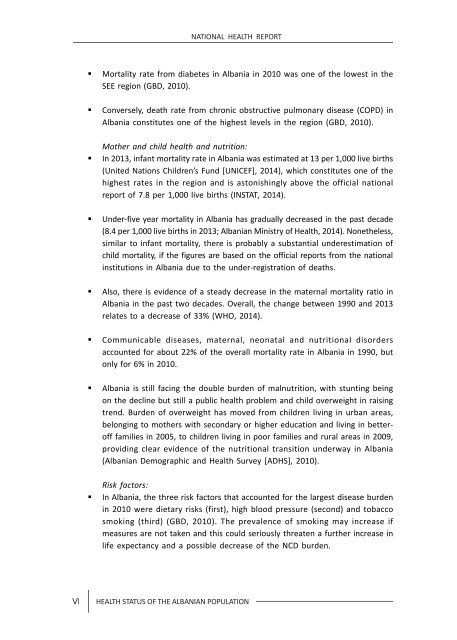Health-report-English-version
Health-report-English-version
Health-report-English-version
- No tags were found...
Create successful ePaper yourself
Turn your PDF publications into a flip-book with our unique Google optimized e-Paper software.
NATIONAL HEALTH REPORT• Mortality rate from diabetes in Albania in 2010 was one of the lowest in theSEE region (GBD, 2010).• Conversely, death rate from chronic obstructive pulmonary disease (COPD) inAlbania constitutes one of the highest levels in the region (GBD, 2010).Mother and child health and nutrition:• In 2013, infant mortality rate in Albania was estimated at 13 per 1,000 live births(United Nations Children’s Fund [UNICEF], 2014), which constitutes one of thehighest rates in the region and is astonishingly above the official national<strong>report</strong> of 7.8 per 1,000 live births (INSTAT, 2014).• Under-five year mortality in Albania has gradually decreased in the past decade(8.4 per 1,000 live births in 2013; Albanian Ministry of <strong>Health</strong>, 2014). Nonetheless,similar to infant mortality, there is probably a substantial underestimation ofchild mortality, if the figures are based on the official <strong>report</strong>s from the nationalinstitutions in Albania due to the under-registration of deaths.• Also, there is evidence of a steady decrease in the maternal mortality ratio inAlbania in the past two decades. Overall, the change between 1990 and 2013relates to a decrease of 33% (WHO, 2014).• Communicable diseases, maternal, neonatal and nutritional disordersaccounted for about 22% of the overall mortality rate in Albania in 1990, butonly for 6% in 2010.• Albania is still facing the double burden of malnutrition, with stunting beingon the decline but still a public health problem and child overweight in raisingtrend. Burden of overweight has moved from children living in urban areas,belonging to mothers with secondary or higher education and living in betterofffamilies in 2005, to children living in poor families and rural areas in 2009,providing clear evidence of the nutritional transition underway in Albania(Albanian Demographic and <strong>Health</strong> Survey [ADHS], 2010).Risk factors:• In Albania, the three risk factors that accounted for the largest disease burdenin 2010 were dietary risks (first), high blood pressure (second) and tobaccosmoking (third) (GBD, 2010). The prevalence of smoking may increase ifmeasures are not taken and this could seriously threaten a further increase inlife expectancy and a possible decrease of the NCD burden.6IVHEALTH STATUS OF THE ALBANIAN POPULATION


